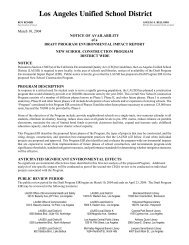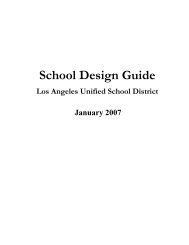Site-Specific Health and Safety Plan (HASP) - Laschools.org
Site-Specific Health and Safety Plan (HASP) - Laschools.org
Site-Specific Health and Safety Plan (HASP) - Laschools.org
Create successful ePaper yourself
Turn your PDF publications into a flip-book with our unique Google optimized e-Paper software.
Screening data <strong>and</strong> definitive data quality levels will be used as indicated below:<br />
• Screening analyses will be used for screening air in worker breathing zones for<br />
health <strong>and</strong> safety purposes. This category may also be used to select sample<br />
portions for further analysis. For example, soil sample headspace may be screened<br />
to determine if laboratory analyses are required.<br />
• Definitive analyses will be used to satisfy the requirements for site<br />
characterization. Definitive data acquired during the investigation will be used to<br />
evaluate COPCs.<br />
2.2 DATA QUALITY ASSESSMENT CRITERIA<br />
DQA criteria will be used to evaluate the quality of the field sampling efforts, field<br />
screening results, <strong>and</strong> fixed-base laboratory results for compliance with project DQOs.<br />
The DQA criteria are expressed in terms of analytical precision, accuracy,<br />
representativeness, completeness, <strong>and</strong> comparability (PARCC). Procedures used to<br />
assess data accuracy <strong>and</strong> precision are in accordance with USEPA's (1996) Test Methods<br />
for Evaluating Solid Waste: Physical/Chemical Methods, SW-846.<br />
2.2.1 Precision<br />
Precision is the measure of variability among individual sample measurements under<br />
prescribed conditions. The relative percent difference (RPD) between primary <strong>and</strong> field<br />
duplicate samples, laboratory sample duplicate (SD) pairs, <strong>and</strong> matrix spike/matrix spike<br />
duplicate (MS/MSD) sample results demonstrate the precision of the sampling <strong>and</strong>/or the<br />
analysis within the batch of samples. When the laboratory control sample (LCS) results<br />
meet the accuracy criteria (USEPA, 1996), results are also believed to be precise, <strong>and</strong><br />
represent the historical precision among the sample batches of the laboratory,<br />
independent from the sample matrix. This is based on the LCS being within control<br />
limits in comparison to LCS results from previous analytical batches of the same methods<br />
<strong>and</strong> matrices. Precision will be expressed in terms of RPD between the values resulting<br />
from primary <strong>and</strong> duplicate sample analyses. RPD is calculated as follows:<br />
where:<br />
RPD = [(x1 - x2)/X][100]<br />
x1 = analyte concentration in the primary sample,<br />
x2 = analyte concentration in the duplicate sample, <strong>and</strong><br />
X = average analyte concentration of the primary <strong>and</strong> the<br />
duplicate sample = (x1 + x2)/2<br />
Acceptable levels of precision will vary according to the sample matrix, the specific<br />
analytical method, <strong>and</strong> the analytical concentration relative to the method detection limit<br />
(MDL). For field duplicate samples, the target RPDs are ≤ 70 percent for soil samples<br />
<strong>and</strong> ≤ 35 percent for groundwater samples. If the concentration of either duplicate is less<br />
than five times the practical quantitation limit (PQL), a control limit of ± 2xPQL will be<br />
compared against the range of the duplicate pair. The laboratory shall have procedures in<br />
place for establishing <strong>and</strong> updating precision control limits. Typical control limits for<br />
2-2<br />
K:\Depts\Dept48\LAUSD\MSA WORK\QAPP\Draft Final QAPP to DTSC\QAPP for OU 1 RAP.DOC<br />
287







